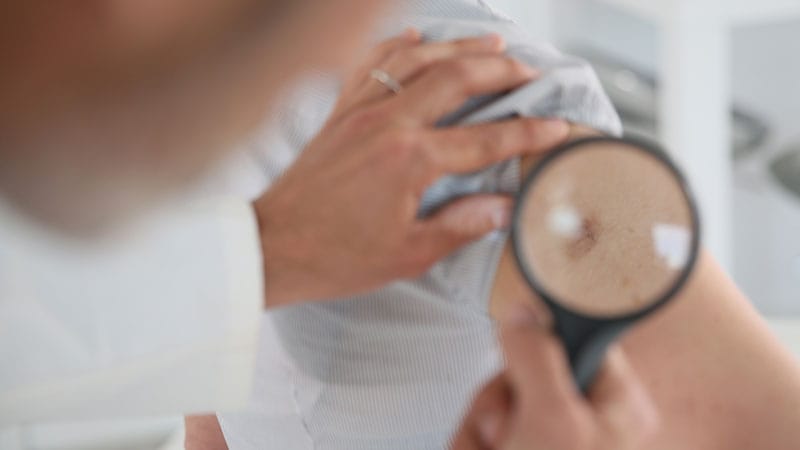Small Melanoma In Situ Lesions Managed with 5-mm Excision Margins Demonstrate Low Recurrence Rates
Grunnleggende konsepter
A 5-mm excision margin for small melanoma in situ lesions on low-risk body sites can achieve a low recurrence rate of 0.9% without compromising patient outcomes.
Sammendrag
This retrospective case series from a single dermatology practice in Australia evaluated the use of 5-mm excision margins for the management of small melanoma in situ (MIS) lesions. The study included 351 MIS lesions diagnosed in 292 patients between 2011 and 2018, with a median follow-up of 7 years.
Key findings:
The mean size of the lesions was 6 x 5 mm, with 78.1% being less than 10 mm long and 88.9% less than 10 mm wide.
Nearly 71% of the lesions were treated with an initial excisional biopsy, and 29.3% underwent an initial shave excision.
Only 3 out of the 351 lesions (0.9%) had a local recurrence, with no regional recurrence or metastatic spread.
The recurrence rate of 0.9% is comparable to the recurrence rates reported in Mohs surgery studies, which ranged from 0.26% to 1.1% with excision margins between 6 and 12 mm.
The authors suggest that using a 5-mm margin for small MIS lesions on low-risk body sites can reduce morbidity and cost associated with treatment without compromising patient outcomes in a selected population of lesions.
The study has limitations, including its retrospective, single-center design and the predominantly small sizes of the lesions. Additional studies are recommended to confirm these findings.
5-mm Margin Excision Evaluated in Small Melanoma In Situ
Statistikk
The mean age of patients was 60.3 years.
55.5% of patients were female.
The mean dimensions of the lesions were 6 x 5 mm.
78.1% of the lesions were less than 10 mm long, and 88.9% were less than 10 mm wide.
71% of the lesions were treated with an initial excisional biopsy, and 29.3% underwent an initial shave excision.
The median follow-up was 7 years.
Only 3 out of the 351 lesions (0.9%) had a local recurrence.
Sitater
"Currently, there is uncertainty regarding the optimal excision margin for MIS, with different guidelines recommending a range between 5 and 10 mm."
"This study demonstrated a comparable 0.9% recurrence rate achieved with a conservative 5-mm excisional margin. This shows that using a 5-mm margin for MIS of smaller size (<10 mm) may reduce morbidity and cost associated with treatment without compromising patient outcomes in a selected population of lesions."
Viktige innsikter hentet fra
by Doug Brunk klokken www.medscape.com 06-26-2024
https://www.medscape.com/viewarticle/excision-5-mm-margins-evaluated-small-melanoma-situ-2024a1000bw2
Dypere Spørsmål
What factors should clinicians consider when determining the appropriate surgical margin for small melanoma in situ lesions?
Clinicians should consider several factors when determining the appropriate surgical margin for small melanoma in situ (MIS) lesions. These factors include the size and location of the lesion, the subtype of melanoma, the risk of recurrence, the patient's overall health and preferences, and the potential for cosmetic outcomes. The size of the lesion is crucial as smaller lesions may require smaller margins, while larger lesions or those with aggressive features may necessitate wider margins. The location of the lesion on low-risk body sites versus high-risk areas can also influence the margin decision. Additionally, the subtype of melanoma, such as superficial spreading melanoma or lentigo maligna, may impact the margin choice. Clinicians should also consider the risk of recurrence based on the histopathological characteristics of the lesion. Finally, involving the patient in the decision-making process and considering their preferences and concerns is essential in determining the appropriate surgical margin for MIS lesions.
How do the findings of this study compare to the recurrence rates and outcomes reported for wider excision margins, such as those recommended in current guidelines?
The findings of this study, which evaluated the use of 5-mm margins for excision of small melanoma in situ (MIS) lesions on low-risk body sites, demonstrated a low local recurrence rate of 0.9%. This recurrence rate is comparable to the rates reported in studies using wider excision margins, such as those recommended in current guidelines. Studies using Mohs micrographic surgery techniques have reported recurrence rates for MIS between 0.26% and 1.1% with excisional margins ranging from 6 to 12 mm. The study's findings suggest that a conservative 5-mm excisional margin for smaller MIS lesions (<10 mm) can achieve similar outcomes in terms of recurrence rates compared to wider margins. This indicates that using a smaller margin may reduce morbidity and cost associated with treatment without compromising patient outcomes in selected lesions.
What are the potential implications of using a smaller 5-mm excision margin for small melanoma in situ lesions on the overall management and treatment approach for this condition?
The potential implications of using a smaller 5-mm excision margin for small melanoma in situ (MIS) lesions on the overall management and treatment approach for this condition are significant. By adopting a conservative margin approach, clinicians may be able to reduce morbidity and cost associated with treatment while maintaining favorable patient outcomes, especially in selected lesions on low-risk body sites. This approach could lead to less extensive surgeries, shorter recovery times, and improved cosmetic outcomes for patients. However, it is essential to consider that not all MIS lesions may be suitable for a 5-mm margin, especially those with high-risk features or located in challenging areas. Further studies are needed to confirm the efficacy of this approach and to identify the specific characteristics of lesions that would benefit most from a smaller excision margin. Overall, using a 5-mm excision margin for small MIS lesions has the potential to optimize the balance between effective treatment and minimizing the impact on patients' quality of life.
0
